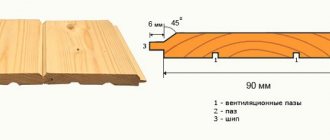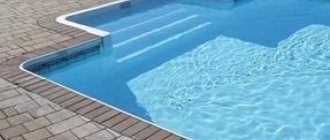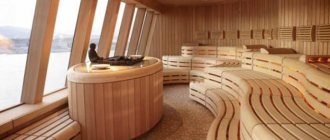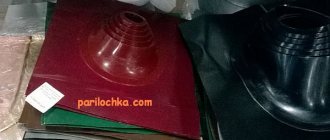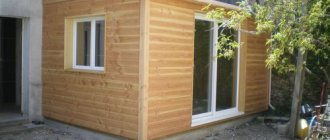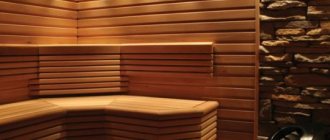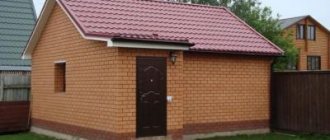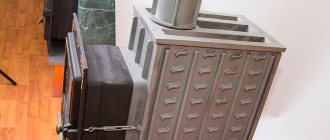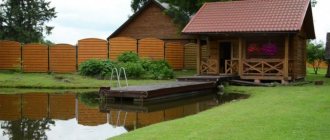When designing, constructing and operating baths and premises of a built-in type of dry heat, that is, saunas (hereinafter referred to as saunas), according to fire safety and sanitary rules, one should refer to the same standards. Moreover, there are rules that require compliance even with private sauna construction. If you plan to become not only a guest in the world of high temperatures and steam, but the owner of an establishment that provides such services, you need to become more familiar with the requirements of inspection structures, primarily the SES (Rospotrebnadzor) and the State Fire Service (State Fire Inspectorate).
The frequency of wet cleaning in apartment buildings is set by the owners at general meetings or by the developer
In clause 8.2 of the MR Rospotrebnadzor elaborated on determining the frequency of wet cleaning of floors in common areas of apartment buildings. Clause 126 of SanPiN 2.1.3684-21 states that this should be done using detergents and cleaning products daily. But in the MR, the department noted that the frequency of cleaning must comply with housing legislation.
The frequency of provision of services and performance of work for the proper maintenance of common property in the apartment building is determined and reflected in:
- OSS decision during direct management of the house;
- management agreement with the management company;
- in the manner specified in the Charter of the HOA or cooperative;
- agreement for the provision of services and performance of work on the maintenance and repair of common property in accordance with Part 1.1 of Art. 164 Housing Code of the Russian Federation;
- decision of the developer in the case provided for in Part 14 of Art. 161 Housing Code of the Russian Federation.
When carrying out sanitary and epidemiological supervision of the maintenance of common areas of MKD, Rospotrebnadzor recommended taking into account the requirements of housing legislation for the frequency of wet cleaning in houses.
On new rules for creating and recording waste collection sites
1739102
equipment requirements
If you plan to equip shower cabins with special showers (needle, rain, circular), they, if possible, are installed in closed cabins.
Open showers in the washing compartments are equipped with special shelves and hooks for placing washing accessories on them, and the booths themselves are separated by a solid partition.
Enclosed showers and baths must include a changing room. Its obligatory attributes are a hanger and a small mirror. It is prohibited to operate bathtubs with damaged enamel in accordance with the provisions of current regulations. Only enamel bathtubs are allowed to be used. As a last resort, it is allowed to install bathtubs with other artificial coatings.
The faucet handles in the washing compartment and steam room must be made from heat-insulating materials.
Visitors are offered basins for washing, which must be made of materials that have high anti-corrosion resistance and immunity to the negative effects of household chemicals (cleaners, disinfectants, detergents). The number of basins is determined by the number of available seats at the rate of 2 basins per visitor.
Basins used to wash feet must be appropriately marked and different in color or shape. Basins with defects (cracks, loose handles, nicks) are prohibited from use. It is also not allowed to use wooden washers for washing.
In the washing department and locker room, bins with lids are installed to collect garbage (brooms, soap) and returned linen. With appropriate markings.
Any bathhouse is equipped with the necessary cleaning equipment. The latter is marked and used strictly differentiated: for the toilet, washing room, locker room. Inventory is stored in a special cabinet or a separate room is allocated for these purposes.
During the operation of the bathhouse, routine cleaning of the premises is carried out periodically. Upon completion of the bath, cleaning and disinfection are carried out.
General cleaning is required weekly. All surfaces of each of the bathhouse premises and the furniture installed in it are disinfected. Identified technical defects are eliminated during general cleaning.
Two types of planned treatment are carried out monthly: disinsection and, in parallel with it, deratization.
Cleaning work is carried out in accordance with the requirements of standard 51870-2002 (GOST).
Property managers should develop a water quality and safety program
According to clause 78 of SanPiN 2.1.3684-21, management organizations must conduct production control of the quality of drinking and hot water. As noted by the Head of the P1 Association, Elena Shereshovets, after eliminating accidents on the in-house engineering networks of the house, the management authority must flush and disinfect the water supply system with mandatory laboratory control of water quality and safety (clause 82 of SanPin 2.1.3684-21).
Rospotrebnadzor in clause 4.7 of the MR indicated that individual entrepreneurs and legal entities operating water supply systems must develop a program for industrial control of the quality and safety of drinking water. Such a program should indicate:
- a list of controlled indicators of drinking water quality and their hygienic standards;
- methods for determining indicators;
- a plan of water sampling points at water intake points, before supplying water to the water supply distribution network and at the point closest to the boundary of the operational responsibility of the house;
- the number of controlled water samples and the frequency of their collection for laboratory research, for each sampling point;
- calendar schedules for water sampling and testing.
The number of controlled water samples and the frequency of their collection are determined for each water supply system individually and are indicated in Appendix 2 to SanPiN 2.1.3684-21.
Why recommendations of the Ministry of Construction of the Russian Federation cannot violate the rights of residents of apartment buildings
34870
Classification of baths
In Russia they are classified according to a number of criteria:
- First of all, technological: The services provided by the baths are divided according to the type of steam room available (they are usually divided into national ones: Finnish, Russian...), as well as by the presence of a swimming pool or its absence;
- Services provided by showers. Can be provided in closed cabins with a bathtub and shower installed there;
- Services of complexes that are bathing and recreational;
- Baths used as: hygienic, combined, mobile, access;
- Public baths;
- permanently located;
- Highest category;
Recommendations are non-binding, but MAs must comply with the requirements of SanPin 2.1.3685-21
In pp. 8.2–8.4 MR lists several more interesting recommendations from Rospotrebnadzor for house managers:
- When assessing the noise level in residential premises, the standards from paragraphs are applied. 100, 104 SanPiN 2.1.3685-21 “Hygienic standards and requirements for ensuring the safety and (or) harmlessness of environmental factors to humans.”
- Deratization and disinfestation in common areas of apartment buildings is carried out by management entities, homeowners' associations or cooperatives, and in the premises of apartment buildings - by their owners.
- In accordance with clause 133 of SanPiN 2.1.3684-21, littering, pollution and flooding of basements and technical underground areas, staircases and cages, and attic spaces in apartment buildings are not allowed.
Let us note that the recommendations of any ministries and departments, including Rospotrebnadzor, are not regulatory legal acts and do not contain binding rules of conduct. As the Supreme Court of the Russian Federation noted, they are advisory in nature. But at the same time, the management must comply with the norms of SanPiN 2.1.3684-21 - these are mandatory requirements for house managers (Part 1.1 of Article 161 of the Housing Code of the Russian Federation).
How to do this correctly, Elena Shereshovets, Head of the P1 Association, told us. She released a series of videos with their explanations for management organizations, homeowners associations and cooperatives:
- in the field of MSW management;
- on water quality control and cleaning in apartment buildings;
- explanations of Rospotrebnadzor on its multiplicity;
- How to convince building residents to raise their rent to meet new requirements.
We hope that they will be useful to you in meeting the mandatory requirements of the new SanPiN 2.1.3684-21.
Northern summer resident - News, Catalog, Consultations
New sanitary and epidemiological requirements for the placement, design, equipment, maintenance and operating hours of public baths and saunas were approved by Rospotrebnadzor. They come into force on June 2.
From now on, baths and saunas are prohibited from opening in multi-apartment residential buildings, including basements and basements. They can now only be located in separate buildings. It was also decided to fight against microbes, fungi and infections.
The premises must maintain strict microclimate parameters: in the locker room the air temperature is 25-28 degrees, in the soap room - not lower than 25 degrees. And cleaning in the baths must be done throughout the working day. Moreover, once a week - general cleaning and disinfection. The ventilation system will be cleaned and disinfected at least once a year. In locker rooms and soap rooms, containers with lids should be installed to collect used linen and bath accessories. At the same time, sanitary doctors do not object if the bathhouses have not only beauty salons for manicure and pedicure, massage, hairdressing and cosmetic services, but also laundries, bars, cafes, restaurants, and shops. And even swimming pools - subject to compliance with the requirements of sanitary legislation.
The new rules oblige the owners of baths and saunas to change the furniture - soft sofas and armchairs have no place there. Finishing materials, bathtubs, basins must also be made of materials that are resistant to corrosion and treatment with disinfectants. The number of cans is also calculated. For one place in the soap bar there should be two basins - for the legs and for the body. Basins for washing feet must be marked “For feet.” Standards have been established for water taps and showers with mixers at the rate of one tap and one shower for no more than 8 people.
Bathhouse attendants and other wash house workers must not only be examined at least once every two years and have personal medical records with information about past infectious diseases, but also undergo professional certification. Industry participants say most of these standards are still being followed. But with the registration of the departmental order in the Ministry of Justice, they acquired the status of mandatory execution and control. Industry experts note that the innovations will lead to the fact that the owners of many “savory” saunas that currently operate in the basements of residential buildings will have to change their registration or name.
By the way, new baths must now be designed, built or reconstructed according to the hygienic principle of flow - this is when guests move in a strict sequence - wardrobe, dressing room, soap room, steam room. Bathrooms are located next to the dressing rooms. The inspectors will have no complaints in this regard regarding bathhouses in old buildings - they were allowed to operate in accordance with the design according to which they were built.
Document text
Resolution of the Chief State Sanitary Doctor of the Russian Federation dated December 20, 2013 N 70, Moscow “On approval of SanPiN 2.1.2. 3150-13 “Sanitary and epidemiological requirements for the placement, design, equipment, maintenance and operating hours of baths and saunas”"
Registered with the Ministry of Justice of the Russian Federation on May 13, 2014.
Registration N 32244
In accordance with the Federal Law of March 30, 1999 N 52-FZ “On the sanitary and epidemiological welfare of the population” (Collected Legislation of the Russian Federation, 1999, N 14, Art. 1650; 2002, N 1 (Part 1), Art. 2; 2003, N 2, article 167; N 27 (part 1), article 2700; 2004, N 35, article 3607; 2005, N 19, article 1752; 2006, N 1, article 10; N 52 (Part 1), Article 5498; 2007 N 1 (Part 1), Article 21; N 1 (Part 1), Article 29; N 27, Article 3213; N 46, Article 5554; N 49, Article 6070; 2008, N 24, Article 2801; N 29 (Part 1), Article 3418; N 30 (Part 2), Article 3616; N 44, Article 4984; N 52 (Part 1), Article 6223; 2009, N 1, Article 17; 2010, N 40, Article 4969; 2011, N 1, Article 6; N 30 (Part 1), Article 4563; N 30 (Part 1), Article 4590; N 30 (Part 1), Article 4591; N 30 (Part 1), Article 4596; N 50, Article 7359; 2012, N 24, Article 3069; N 26 , Art. 3446; 2013, N 27, Art. 3477; N 30 (part 1), Art. 4079; N 48, Art. 6165) and the Decree of the Government of the Russian Federation dated July 24, 2000 N 554 “On approval of the Regulations on state Sanitary and Epidemiological Service of the Russian Federation and the Regulations on State Sanitary and Epidemiological Standardization" (Collected Legislation of the Russian Federation, 2000, No. 31, Art. 3295; 2004, N 8, art. 663; N 47, art. 4666; 2005, N 39, art. 3953) I decree:
Approve sanitary and epidemiological rules and regulations SanPiN 2.1.2. 3150-13 “Sanitary and epidemiological requirements for placement, equipment, maintenance and operating hours of baths and saunas” (appendix).
Acting Chief State Sanitary Doctor
Russian Federation
A. Popova
Application
Sanitary and epidemiological requirements for placement, equipment, maintenance and operating hours of baths and saunas
Sanitary and epidemiological rules and regulations SanPiN 2.1.2.3150-13
I. Scope and general provisions
1.1. These sanitary and epidemiological rules and regulations (hereinafter referred to as the sanitary rules) establish mandatory sanitary and epidemiological requirements for the design, equipment and maintenance of all types of public baths and saunas (hereinafter referred to as the baths).
1.2. These sanitary rules do not apply to facilities that are in the design, construction, reconstruction and commissioning stages at the time these sanitary rules come into force.
Previously constructed bathhouse buildings are operated in accordance with the project according to which they were built.
1.3. Control over the implementation of these sanitary rules is carried out in accordance with the legislation of the Russian Federation by bodies authorized to carry out federal state sanitary and epidemiological supervision1.
II. Sanitary and epidemiological requirements for the placement and construction of baths
2.1. Baths should be located in separate buildings. The installation of bathhouses in multi-apartment residential buildings is not allowed.
2.2. When designing, constructing and reconstructing baths, the internal layout of the main premises must comply with the hygienic principle of flow, which provides for the possibility of sequential movement of visitors according to the scheme: wardrobe, dressing room, soap room, steam room. Bathrooms are located next to the dressing rooms.
2.3. In the baths it is allowed to place: premises for the provision of services - manicure and pedicure, massage, hairdressing and cosmetic services; laundries; catering facilities, retail trade, swimming pools - subject to compliance with the requirements of sanitary legislation for their placement, design, equipment and operation.
2.4. Bathhouse buildings are equipped with hot and cold water supply, sewerage, heating, and ventilation systems. To achieve optimal microclimate parameters, the installation of air conditioning systems is allowed.
2.5. Cleaning and disinfection of mechanically driven supply and exhaust ventilation systems should be carried out at least once a year.
2.6. In the absence of a centralized sewerage system, bathhouse buildings are equipped with local treatment facilities.
2.7. Bath water supply systems must ensure an uninterrupted supply of cold and hot water that meets the sanitary and epidemiological requirements for water quality of centralized drinking water supply and hot water supply systems.
2.8. Lighting in bathhouses must comply with hygienic requirements for natural, artificial and combined lighting of residential and public buildings.
III. Sanitary and epidemiological requirements for equipment, maintenance and operating hours of baths
3.1. To decorate bathhouses, materials are used that are resistant to moisture, temperature, detergents and disinfectants.
3.2. Furniture installed in bathhouses must have smooth surfaces that are accessible for wet cleaning and resistant to treatment with disinfectants.
3.3. Changing rooms must be provided with separate seats and hangers for the clothes of each visitor.
3.4. Soap bars are equipped with benches made of materials that are resistant to moisture and disinfectants.
Soap rooms are equipped with water taps and showers with mixers at the rate of one tap and one shower for no more than 8 people. It is recommended to provide a separate tap in the soap room with hot and cold water supply for washing walls, equipment and floors.
3.5. Baths and basins intended for washing must be made of materials that are resistant to corrosion and treatment with disinfectants. The number of cans is taken at the rate of at least two cans per washing area. Basins intended for washing feet must be marked “For feet.”
3.6. Steam rooms are equipped with shelves or seats. The steam room is decorated with materials that are safe for humans.
3.7. The staff room is equipped with individual lockers for separate storage of personal clothing and workwear of bathhouse workers.
3.8. The following microclimate parameters must be maintained in the bathhouse premises: in the dressing room - the air temperature is 25 - 28 C, in the soap room - not lower than 25 C.
3.9. Separate rooms (hereinafter referred to as linen rooms) must be allocated for storing clean and used linen.
3.10. Linen rooms for storing clean linen must be equipped with closed cabinets or racks at a height of at least 30 cm from the floor, with a coating that allows wet cleaning and disinfection.
3.11. Linen rooms for storing used linen must be equipped with racks at a height of at least 30 cm from the floor, with a coating that allows wet cleaning and disinfection.
When storing used linen for more than a day, provision must be made for drying the used linen.
3.12. In dressing rooms and soap rooms, containers with lids should be installed to collect used linen, brooms, and bath accessories.
3.13. Baths are provided with cleaning equipment, which must be marked and used in accordance with the marking depending on the purpose of the premises (toilet, entrance group of premises, soap and steam room, dressing room), stored in specially designated areas or in a separate closet.
3.14. During the working day, routine cleaning should be carried out in the bathhouse premises: washing the floors, benches in the dressing rooms, as well as washing the floors, benches with a hose in the soap and steam rooms. At the end of the working day, in the absence of visitors in the bathhouse, all premises are cleaned using disinfectants.
3.15. Once a week a day is allocated for general cleaning. During general cleaning, the surfaces of floors and walls in all rooms, as well as benches in changing rooms, soap rooms and steam rooms, are washed using disinfectants.
Elimination of current finishing defects (elimination of leaks on walls and ceilings, cracks, crevices, etc.) is carried out during general cleaning.
3.16. Deratization and disinfestation are carried out at least once a month.
3.17. Waste generated as a result of bathhouse activities must be collected and disposed of.
3.18. Bathhouse workers must undergo preliminary, upon employment, and periodic medical examinations in the prescribed manner2; certification for knowledge of these sanitary rules at least once every 2 years.
Bathhouse workers must be vaccinated in accordance with the national calendar of preventive vaccinations, as well as according to epidemic indications3.
Each bathhouse employee must have a personal medical record, which must contain the results of medical examinations and laboratory tests, information about vaccinations, previous infectious diseases, information about undergoing professional hygienic training and certification, and permission to work.
3.19. Bathhouse workers must be provided with special clothing and personal protective equipment. Laundry of work clothes must be organized.
1Resolution of the Government of the Russian Federation dated 06/05/2013 N 476 “On issues of state control (supervision) and invalidation of certain acts of the Government of the Russian Federation” (Collected Legislation of the Russian Federation, 2013, N 24, Art. 2999)
2Order of the Ministry of Health and Social Development of Russia dated April 12, 2011 N 302n “On approval of lists of harmful and (or) hazardous production factors and work, during the performance of which mandatory preliminary and periodic medical examinations (examinations) are carried out, and the Procedure for conducting mandatory preliminary and periodic medical examinations (examinations) workers engaged in heavy work and in work with harmful and (or) dangerous working conditions" (registered by the Ministry of Justice of Russia on October 21, 2011, registration N 22111, as amended by order of the Ministry of Health of Russia dated May 15, 2013 N 296n, registered by the Ministry of Justice of Russia on July 3. 2013 N 28970).
3Order of the Ministry of Health of Russia dated March 21, 2014 N 125n “On approval of the national calendar of preventive vaccinations and the calendar of preventive vaccinations for epidemic indications” (registered by the Ministry of Justice of Russia on April 25, 2014, registration N 32115).
www.rg.ru
| < Previous | Next > |
At the dawn of history
Since ancient times, since the times of the sages of Ancient Greece, public baths have been the concentration of giants of thought and the fathers of democracy there. It was there that, in addition to the adoption of hygienic and general health procedures, heated and, at times, fierce disputes arose regarding the meaning of existence and the essence of the mortal world.
There, great discoveries in the fields of arithmetic, physics and geometry were often born. The good initiative of the Greeks was picked up by no less great Rome. The Romans gradually began to introduce mass baths for citizens of the empire. The famous city baths of Diocletian were able to simultaneously accommodate about 3,000 people.
In addition to the bath areas themselves, there were lecture halls, gymnastics, playgrounds and other useful bonuses. Not bad at this time, isn’t it?
The water supply system, advanced at that time, was provided by the abundant flow of aqueducts and included almost full-fledged water supply and sewerage. The benefits of ancient Roman civilization were successfully destroyed by the barbarians in 537, who considered such achievements unnecessary. From this time on, the decline of the classical Roman bath began.
It was remembered only in 1856, when the Irish doctor Richard Barter, in collaboration with the famous popularizer of Turkish baths in the British Isles, David Urquhart, built classic Roman baths, but somewhat modernized, on the Irish hills near Blarney.
Due to the introduction into the design of elements of Irish dry-air baths with their perfect air supply and ventilation systems, and stoves heated by inexpensive, but extremely high-calorie fuel - British Cardiff coal.
The public liked the baths so much that they immediately moved from the islands to the continent and from there began their triumphal march across Europe.
Sandunovo baths - the pride of the empire
In Russia, the bath industry loudly declared itself in 1808 with the opening of the legendary Sandunovsky baths, or Sandun, in common parlance. It was there, in the floodplain of the Neglinnaya River, that an establishment was formed that has retained its main profile to this day.
Moscow poured into them, especially into the men’s and women’s “noble” departments, arranged with amenities previously unheard of in Moscow: a dressing room with a mirrored hall, with clean sheets on soft sofas, well-trained servants, experienced bath attendants and bath attendants. The dressing room became a club where the most diverse society met - everyone found here their own circle of acquaintances, and, moreover, a buffet with all kinds of drinks, from kvass to Moët and Aya champagne. Both Griboyedov's and Pushkin's Moscow visited these baths, the one that gathered in the salon of Zinaida Volkonskaya and in the English Club.
Reporter Gilyarovsky, a great connoisseur of metropolitan life, wrote in his book “Moscow and Muscovites”.
It was this circumstance, a certain club component and innovation that created the name and well-deserved fame for the Sandunov Baths.
It is worth noting the technical equipment. After reconstruction at the end of the 19th century, water was delivered by steam pumps through a separate drinking water supply from a water intake on the Moscow River and a deep artesian well. In addition, there was electric lighting, which was rare at that time. The decoration was amazing and was made by the best craftsmen from European materials. The pricing policy also remained reasonable and balanced, general departments were priced from 5 to 50 kopecks, individual rooms and apartments from 60 kopecks to a considerable 5 rubles in those well-fed times.
Age of Industrialization
In the country of victorious socialism, the city bathhouse continued to play a very important role, as an effective means of personal hygiene and simply as an iconic public platform. Few houses could boast of having not only a bathroom, but also running water and sewerage as such.
The rapidly growing industrial centers in the European part of the country required workers, but could not always provide their owners with at least some living space. Old barracks and landowner stables were also used for settlement. The dormitories under construction were also not always famous for their relative comfort. Under these conditions, factory baths came to the aid of city baths.
Nowadays
In the modern world, when the bathroom has ceased to be exotic, there has been an increase in interest among the population of large cities in public baths. Thus, on the website of one large city with a population of one million, a public initiative appeared on the establishment of such seemingly forgotten entities as municipal baths. The initiative was joyfully received and supported by the population in the shortest possible time.
Personnel requirements
When applying for a job in a bathhouse, the future employee is required to undergo a medical examination and provide (get) a medical record.
In the process of work, he is obliged, according to existing schedules, to regularly undergo a medical examination with a note in his personal medical record. It must include:
- Laboratory test results;
- Information about past infectious diseases;
- Information about vaccinations received;
- About the hygienic training completed (taken once every couple of years);
The “Qualification Directory”, which was approved on February 20, 1984 by a joint resolution of the All-Union Central Council of Trade Unions and the USSR State Committee for Labor No. 58/3-102 (as amended on March 15, 1991), establishes that a worker serving a bathhouse must know and comply with:
- Current sanitary rules and standards for customer service in the bathhouse;
- Equipment design and procedure for its operation;
- Fire protection rules and safety measures;
- Price list of the cost of services provided;
- Rules approved as the internal regulations of a particular bathhouse;
- Massage therapists, medical workers and employees of the health and prevention department must have specialized education and medical books.
